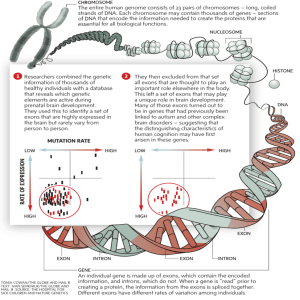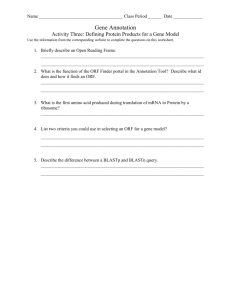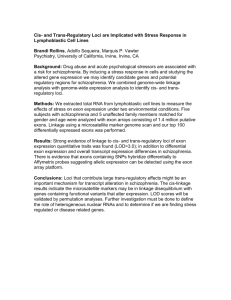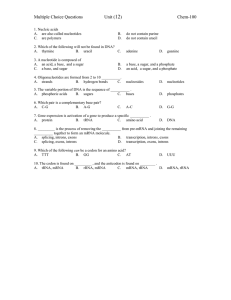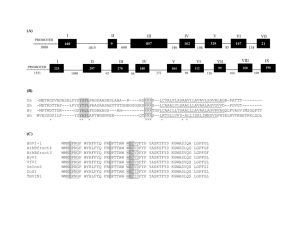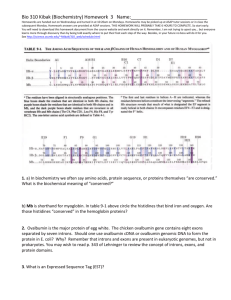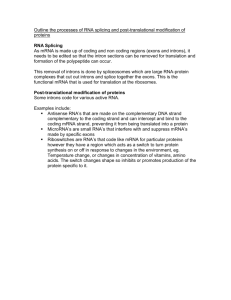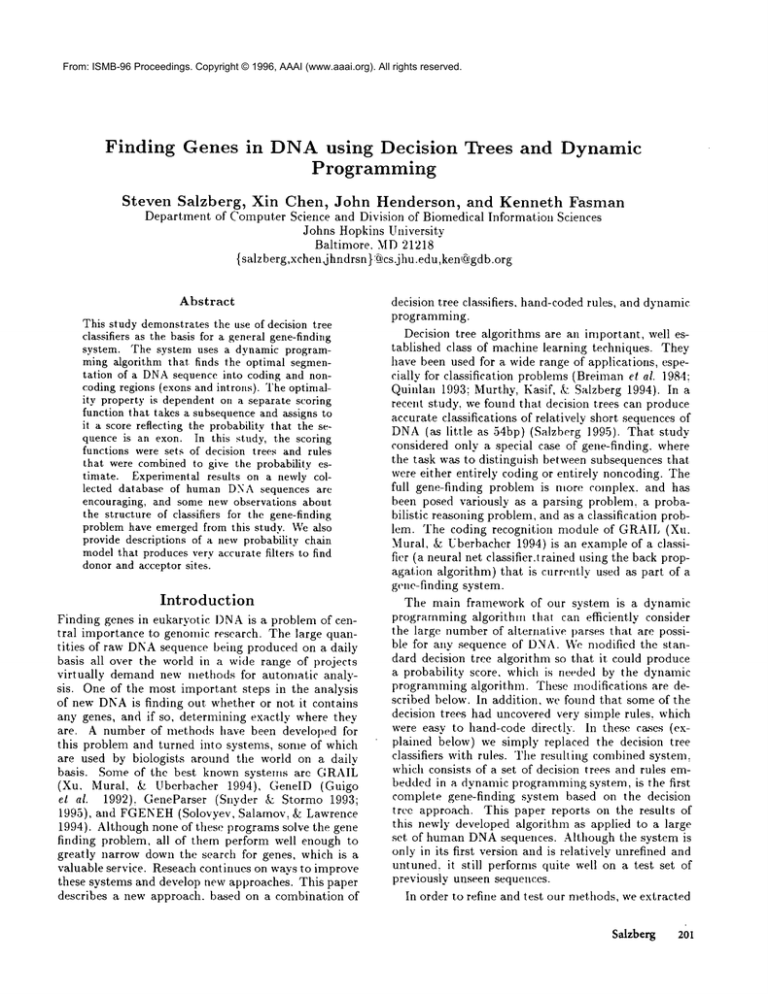
From: ISMB-96 Proceedings. Copyright © 1996, AAAI (www.aaai.org). All rights reserved.
Finding
Genes in DNA using Decision
Programming
Trees
and Dynamic
Steven
Salzberg,
Xin Chen,
John Henderson,
and Kenneth
Fasman
Department of Computer Science and Division of Biomedical Information Sciences
Johns Hopkins University
Baltimore. MD21218
{ salz berg,xchendhndrsn}:~cs.jhu .edu,kewf~gdb.org
Abstract
This study demonstratesthe use of decision tree
classifiers as the basis for a general gene-finding
system. The system uses a dynamic programming algorithm that. finds the optimal segmentation of a DNAsequence into coding and noncoding regions (exons and introits). ]’he optimality property is dependentoll a separate scoring
function that takes a subsequenceand assigns to
it a score reflecting the probability that the sequence is an exon. In this study, the scoring
functions were sets of decision trees and rules
that were combinedto give the probability estimate. Experimental results on a newly collected database of human DNAsequences are
encouraging, and some new observations about
the structure of classifiers for tile gene-finding
problem have emerged from this study. Wealso
provide descriptions of a newprobability chain
modelthat producesvery accurate filters to find
donor and acceptor sites.
Introduction
Finding genes in eukaryotic I)NA is a problem of central importance to genomic research. The large quantities of raw DNAsequence being produced on a daily
basis all over the world in a wide range of projects
virtually
demand new methods for automatic analysis. One of the most important steps in the analysis
of new DNAis finding out whether or not it contains
any genes, and if so, deterinining exactly where they
are. A number of methods have been developed for
this problem and turned into systems, some of which
are used by biologists around the world on a daily
basis. Some of the best known systems are GRAIL
(Xu, Mural, & Uberbacher 1994), GenelD (Guigo
el al. 1992), GeneParser (Snyder & Stormo 1993;
1995), and FGENEH
(Solovyev, Salamov, & Lawrence
1994). Although none of these programs solve the gene
finding problem, all of them perform well enough to
greatly narrow down the search for genes, which is a
valuable service. Reseach continues on ways to improve
these systems and develop new approaches. This paper
describes a new approach, based on a combination of
decision tree classifiers, hand-coded rules, and dynamic
programming.
Decision tree algorithms are an important, well established class of machine learning tectmiques. They
have been used for a wide range of applications, especially for classification problems(Breilnan et al. 1984;
Quinlan 1993; Murthy, Kasif, & Salzberg 1994). In
recent study, we found that decision trees can produce
accurate classifications of relatively short sequences of
DNA(as little as 54bp) (Salzberg 1995). That study
considered only a special case of gene-finding, where
the task was to distinguish between subsequences that
were either entirely coding or entirely noncoding. The
full gene.-finding problein is more complex, and has
been posed variously as a parsing problem, a probabilistic reasoning problem, and as a classifcation problena. The coding recognition module of GRAIl, (Xu.
Mural, & Uberbacher 1994) is an example of a classitier (a neural net classifier.t rained using the back propagation algorithm) that is currently used as part of
gene-finding system.
The main framework of our system is a dynamic
programming algorithm that can efficiently consider
the large numberof ah.ernal.ive parses that are possible for any sequence of DNA.Wemodified the standard decision tree algorithm so that it. could produce
a probability score, which is needed by the dynamic
progratnming algorithm. These modifications are described below. In addition, we found that some of the
decision trees had uncovered very simple rules, which
were easy to hand-code directly. In these cases (explained below) we simply replaced the decision tree
classifiers with rules. The resuhing combined system,
wMchconsists of a set of decision trees and rules embedded in a dynamic programming system, is the first
complete gene-finding system based on the decision
tree approach. This paper reports on the results of
this newly’ developed algorithm as applied to a large
set of human DNAsequences. Although the system is
only in its first version and is relatively unrefined and
untuned, it still performs quite well on a test set of
previously unseen sequences.
In order to refine and test our methods, we extracted
Salzberg
201
a large collection of human genomic DNAseqm,nces
from the Genonte Sequence Data Base ((.;SI)B).
then carefully liltered this data to remove any obvious
inconsistencies, and we only retained complete coding
sequences for our experiments. This data is described
more fully in Sect.ion , after which we describe our
algorithtus attd our experimental results.
Assembling
a collection
DNA sequences
¯ is obtained [’reel human DNA
¯ is greater than 500 nucleotides in length
¯ contains a complete coding sequence (CDS), including both 5’ and 3’ ends
¯ COlltains at least. OIle exou
Because of (;Sl)l]’s implementation in a relational
database managementsyst.en, (Sybase). pointers to the
basic data set can be obtained with a singh’ query,
which is impossible with any other public sequence
database. The final version of our data, which was
retrieved in early August19,(.)5, will soon be madeavailable on our Website.
It is well knownthat the quality of the entries in
the DNAsequence databases varies dramatically (e.g.,
(Kristensen, Lopez. L" Prydz 1992; White el al. i993)).
Poor quality sequence data can be caused by everything from vector contamination to erroneous annotat.ion of sequence features. Althot,gh each of the contributing databases has its ownquality control checks.
they are not unifl~rmly applied at. all sites.
ISMB-96
Nuln.
SO(lllellCes
Training
Test
295
100
of
Total
length
2147903
716226
Total c.xon
h’ngth
:1742.11
1,16473
Tabh, 1: Characterization of the l,ulnali 1)NAdata.
of complete
The classification rules used in a gene finding system
must be tuned t.o recognize feat ur,-’s of coding anti noncoding sequences. This tuning process involves the ad.iustlnent of various algorithm parameters, and the final accuracy of the syst.em depends to a large extent
on the quality and quantity of data used to train t.hcnL
Wetherefore placed considerable emplmsis on the development of a reliable training set. (We are using
tiffs same colh’ction of data in a companionstudy on a
gene-finding systenl based on Hidden Markov Models
(Henderson. Salzberg. & Fasrnart 1996).)
Ad hoc query access to scientitic databases via a
standard query mechauism is essential for a study of
this kind (Waterman el al. 199.1). Large numbers of
DNAsequences must be gathered which meet rigorous
criteria. "[’he GenomeSequence Data Bast, (Cinkosky,
Fickett, & Keen1995) was therefore the clear choice as
our primary source of human DNAsequences. Among
tim major puMic imcleotide sequence databases (including Genbank. EMBLData Library. and DDB.I),
GSDBis the only ()tie thal supports publicly accessible SQLqueries. This feature is of critical importance
in obtaining a well-defined set of sequences from the
database, and easily ul>dat.ing that set. as new data
becomes available.
The defining features of all sequences ill our data set
are as follows, l’;ach sequence:
202
Data se!
Onceour initial data set. was obtainecl, a numberof
quality controls had to be applied t.o remove entries
which did not meet our standar(ls. Weapplied filters
to the raw data set to find and remow~sequences with
overlapping exon and intr(m ranges or with excms defined out of the range of the coding region. \\’e also
manually removed the entry for the humangerrnline Tcell receptor beta chain gene (Hood ~l al. 1993) from
our data set. Although this entry is the largest single humansequence currently in the datalmse, and it
is a modelfor careful, dense annotation, it, is atypical
because of the V. D, and J segment structur,’.
This,
combinedwilh its very large siz..’ madeit. very difficult
to process, and uh, imately easier to h,av,’ out of our
data set.
Ewmafter this filtering, we. expect that manyerrors
remain in the data. For example, we have no easy way
of detecting gen,’s where alt.ernative splicing occurs.
and it is often impossible to detect insertion and deletion errors. A more fundamental problenl is that annotations placed in the data base are inconsistent: we
haw, (’twountered manycases wh(’re the first exon was
apparently defined as beginning at. the ATGsite, but.
there are manyothers where the first exon begins lipstream of the AT(-;. I,ikewise. manyIleal exous are annotated as ending wit h a stop codon, whih" manyor.hers inclu(I,.’ the stop codonin the midtlh’. Thefinal data
set is dc.’scribed in Table 1. Weare also using a second,
st,m.ller data set. that was part of a large comparative
study of GRAIl,, C, enel~arse. C, enelD, FGENEII.(lenLang, SORHND,and XPound (Burset & Guigo 1996).
This data set. contained 570 vertebrate sequences, from
which we selected all the humansequences, giving us
!)3 sequences. (The accession nuntbers and data can
be obtained by ft.p; send email to salzberg,a~cs.jhu.edu
for instructions.) I"or this data, we used 6:1 sequences
for training and reserved 30 for testing. This dala is
"cleaner" thau ours in that ntany problems were filtered out. such as sequellces with llOn-COllSetlStlS sp]ice
sites, sequences whose first exon did not start with
ATG, sequences whose last exon did not end with a
stop codon, aim others (see (Burset & (;uigo 1996)
details). Ahhoughch’aner, this data set provides
basis for comparison with other systems and was included for this reason. All of the training and tuning
of the gene-finding system was conducted exchlsively
on the training sels. After training, the syslelll
was
run without further adjus~ ments on the test data.
Decision
trees
for classifying
regions
coding
Our decision tree software is based on the OC1decision
tree system (Murthy, Kasif. & Salzberg 1994), which
is available freely over the Internet 1. The OC1system
was shown in a previous study to be very effective at
labeling short, homogeneous pieces of DNAas coding
and noncoding (Salzberg 1995). OC1is a randomized
decision tree system, which because of this property
produces a slightly different decision tree on each run.
Weconstructed ten different decision trees from our
training data, and combined their outputs to label a
segment of DNAwith the probability that it is a coding
region. Details of the systelu can be found in Murthy
et al. (Murthy. Kasif, &Salzberg 1994).
A decision tree system produces as output a simple
tree data structure to be used as a classifier, as shown
in Figure 1. This figure shows part of a tree that was
generated for this study. The internal nodes of the
tree contain fealures that are calculated for each subsequence as it is passed to the tree. Features used here
included dicodon usage. Fickett’s asymmetry measure,
the sequence length, and the autocorrelation, run, and
Fourier measures from Fickett and Tung (Fickett
Tung1992). To classiC a sequence, it is first converted
into a set of feature values, and this is the representation that is given to the decision tree. The bottom of
the tree (its leaf nodes) contains class labels indicating
whether the subsequence is coding (exon) or noncoding. Unlike standard decision trees, the system here
needed to conw~rt these class labels to numbers.
Wefirst ran a simple experiment to determine how
well a decision tree could distinguish between whole exons and whole introns. (lsing our training data set., we
ran a cross-validation experiment and found that the
trees could obtain 94(7(:. accuracy on this problem. Details are given in Section . This experiment convinced
us that decision trees could provide a good basis for a
dynamic programming approach to gene finding. The
dynamic program, though, needs a numeric score for
each potential exon, not just a class label, so OC1had
to be modified.
ModifyingO(’l (or any decision tree system, in fact)
to produce numeric scores is fairly straightforward, and
works as follows. At. the leaf nodes of every tree, we
store not just the label of the majority class, but the
distributions of all classes found at. that node. For example, if a leaf node contains 40 exons and 20 introns,
instead of just storing the label "’cxon" one cal, store
the distribution (i.e., 40/60 exons and 20/60 introns).
As stated above, we create 10 trees from the training
data, which serves to make the system less sensitive to
peculiarities that mayexist in a single tree. To classify
1 The
system
is
available
on
the
Webat http://www.cs.jhu.edu/lal)s/compbio/home.html.
It is also available via ftp at ftp.cs.jhu.edu, in the directory
pub/ocl.
a new sequence, we compute the saine features that
were computedfor all the training sequences, and then
use those features to classify the sequencein each of the
10 trees. The distributions returned are then averaged,
giving a probability score for each of the classes.
A dynamic
programming
algorithm
to
segment
DNA
Dynamic programming is the name of a large class of
algorithmic methodsthat use a simple principle: in order to find the optima[ solution to a problem, break the
problem into smaller problems, compute their optimal
solution, and then glue those solutions together. Fortunately, tile gene-finding problem fits this framework
perfectly.
Our dynamic programming (DP) algorithIn finds
segmentation of a DNAsequence into alternating coding and noncoding regions that is guaranteed to be
optimal. This is possible because DPconducts all exhaustive search through all possible optimal solutions.
Note that there are an exponential number of ways to
parse a sequence into exons and int.rons; however, the
advantage of the DPalgorithm is that it. prunes off
large numbers of these possibilities, considering only
those alternatives that are candidates for the optimal
solution.
Dynamic programming has been used for
gene-linding previously by Snyder and Stormo (Snyder & Stormo 1993) in combination with a feedforward
neural network. It has also been used for partitioning
amino acid sequences (Sankoff 1992) and, in a similar
but. more general context, in our own work on partitioning sequences of arbitrarily labeled objects (Fulton,
Kasif. & Salzberg 1!)95). Wu(Wu1995) proposed
DPformulation most similar to ours, though it has not
t)een implemented.
The input to our dynamic programmingalgorithln is
a complete DNAsequence. The output is a partitioning of that sequence into an initial noncoding region.
followed by alternating exous and introns, following by
a final noncoding region. This partitioning is optimal
with respect to the scores produced by the scoring algorithm (which in our system is a set of decision trees
and rules).
The basic formulation can be expressed straightforwardly with the help of a matrix D(t,n). (This notat.ion is similar to that used by Suyder and Storma
(.1995.) D(t, n) will keep the score of the optimal parse
of a sequence b’ ending in a subsequence of type t at
location n. The different sequence types are:
1. initial noncoding region
2. initial exon
3. internal exon
4. intron
5. final exon
6. final noncoding region
The scoring algorithm returns a score P,(i,j) which
the probability that the subsequence from i to j is a
sequence of type t. The algorit.hm processes a sequence
Salzberg
203
...................
~:::::~:.-------
........................................
Open
Re~,<Jing
Fran~
[-A~y(g
I
A’~:,<O
I,
I
A,,,:,
Z
I
Z
oo. ¯
--’
|hlner
i
C~,:nReading
Fr~n~:
I
I
I
I
I
I
Dit~,’d¢,,,(O’,O
6Aul’"g’
Ol~:n
Frarl~ .~.~y(O
~A .....
Ii Reading
l i
0
0
i
o
i~"
I
I
i ~rl~lli
I
.~
¯
.
¯
.
¯
¯
¯
I
¯
.
¯
.=
¯
z°
o
~
,~
I
Apy{~,
Aul,,lal
I
t
Aumla+
I
Run
A?’(g)
I
Aut,,tl)
I
l
I
I
_~
IQ
¯ .
¯
¯
........
¯
.
¯
¯
¯
¯
,_b" from h,fl, to right., and at each location it. computes
the best parse by choosing:
maxl<i<,, D(tv~,.., i)
+Pt(i + 1. n)(nPt(l. n)
That is. at each location n., to conlpute the score of th(’
best parse that ends hi each type t, we comtmte the
score of the subseqtmnce[i-i- 1, n] as a sequence of type
t and add that to the score of the optimal parse on [1. i]
ending with type tv,-ev, which is the segment type compatible wit.it 1. Theseprevious optinlal parses are found
in the appropriate D matrix. Note that. the score P is
normalized by the length of the sequence, so the algorithm will maximizethe score per base for the whole sequence. (Snyder and Stormo (Snyder ,t,: Stormo 1993)
tised a different approach: they converted their prot)ability scores to log likelihoods and then added them
together. The cornputation here cotnputes the average
probability scor,’ per base for the sequence.)
Frame consistent
dynamic
programming
To this fornndation we add one additional but. crucial complication: in order t.o produce a ’qegM"parse.
the coding regions must not contain any in-frame stop
codons when concatenated together. If one sin]ply
che(’ks for frame consistency ar, d eliminates solutions
that are not consistent, the algorit.hm ca]] no longer
guarantee at] optimal parse (and, it] fact. it will frequently produce suboptimal parses). The t’)roblem cat]
he illustra.ted as follows:
noncoding [ El [ I1
noncoding
I E2 I I2
] E3 [
I E4
[
Suppose we have the two partial parses shown above two different possibh’ initial exons, in different frames,
with introns that could end at the same location i. The
D matrix will store ouly the higher-scoring parse at i.
Thus if the first parse scores higher, the second parse
is lost, eveu though the secot, parse is in a different
reading frame. But it is quite possible that exons 2
and 4 rornl a higher scoring parse than exons 1 and
3. Note that if the algorithm does not do any frame
204
ISMB-96
..
;ei~gth I
l)l~u&,nl
I
I
.
¯ ¯
I
¯
oO
Q,
g
¯
.
¯
¯
¯
.
z°
Figure l Sampledecision tree for cla.ssi[~’ing
D(I, n) = max
I
A~yL~
I
humanI)NA
co,tsistency check]]|g, it will find the highest score, but
it ]nay not be reading frame consistent.
Therefore at eve.ry location n, we rnust keep a separate D matrix for each of the three reading fr;,tnes.
At each location, we keep the optin]al parse ending in
a sequence of type I in frame f, for f E (0, 1.2). The
system thus needs eighteet~ matrices.
Assumptions and constraints
There are a number of inter-region constraints and
assumptions that cat] t)(,, made for the gene-finding
problem, and many of these were incorporated into
our system. These constraints are imn]ensely valuabh+,
for without then] the algorithm will have t.o compute
the optimal parse for every single location in .’very sequence, which is computationally very costly. Ill addition, by giving the system more possibilities to compare, it makes the gene-finding problem itself more dif[i+,’lllt .
Fortunately, the biology conlmunity has uncovered
many important facts about gene splicing and t.ranscrip]ion, some of which cat] be used to help the system. The constraints we considered are as follows (Mthough, as noted below, seine were not used in the final
version of the system):
1. Th,, first exon of every gene begirls with the start
codon.
2. A gene can have only one stop codon it] the same
reading frame as the start, codon, and that stop
codon nmst appear as the last codon in the g~ene.
3. Eachnon-initial exon n]ust be it] phase with tile previous eXOll.
4. Each piece of I)NApres(’nted for analysis will start
aim end wit It a noncodingregion and contain a single
Celle.
lhere are a number of signals which denote bot,ndaries between exons and introns(Solovyev. Salamov,
,k Lawrence 1994; Mount. Peng, & Meier 1995). We
can find all boundaryca,Midates (which is a superset
of Ill(’ true hol,ndaries) by looking for these signals.
These assumptions, although helpful, have a nund)er
of shortcomings. There are many genes in which the
stop codon ar.pears in the middh, of the last exon. The
start codoncan appear after the start of transcril>tion,
.::::
although ill our data this happened very rarely. However, our system is in reality finding the initial and
the final coding region, not the initial and final exons,
because it always uses the start, and stop codons as signals of the beginnings and ends of these regions. We
should note that every other major gene-finding system uses this same assumption, so in a sense, all these
systems are really’ finding coding regions, not genes.
Assumption 4 is used by our system and most other
gene-finders; however, it is the one assumption that
needs to be removed to create a truly general genefinder. (After all, an uncharacterized DNAsequence
maycontain no genes at. all. or it maycontain several
genes. )
Constraint 3 elinlinates a large number of candidate
solutions by requiring that the reading frames of all the
exons in a parse be consistent: i.e., whenthe exons are
concatenated, the resulting sequence has no in-frame
stop codons.
Because our system assumes that all first exons start
with ATGand all last exons end with stop, it would
be more accurate to call it a "coding region" system.
Weuse the phrase "gene-finding" because it seems to
be the convention adopted by the field.
Splice site selection
The knowledge of splice junction signals (the boundaries between exons and introns) provides very important clues as to where the true gene might be. Guided
by the splice site consensus information collected by
Mount (Mount et al. 1992; Mount, Peng, & Meier
1995), we created a pre-processor that scanned every sequence and scored every location on how well
it matched the 5’ and 3’ consensus sites. Weused a
9-base region around the 5’ (donor) site and a 15-base
region around the 3’ (accepter) site. In order to compute these sites, we computed the probability of each
base in each position in our training data. Wethen
stored in a matrix the score Mb,i = ln(fb,i/pb), where
fb,i is the frequency of base b in location i of the site
and Pb is the prior probability of base b in the data.
Using the same method as Snyder and Stormo (Snyder
& Stormo 1995) we scored a site by adding these log
ratios: a new site si.si+l,...,sj
is scored by:
J
S(i,j)
= EM’kk
k=i
To pre-process the data, we applied this scoring function to all the true sites and then to a large selection of
random sites. Wethen selected a cutoff score that excluded very few of the true sites (about 3-4%) included
only about 1%of the random (false positive) sites.
One drawback of this site statistic is that the addition of log ratios is valid only under the assumption
that the bases in a site are independent of one another.
This assumption is clearly false, and to improve the
statistic we cameup with the following new site statistic. For a site with d positions, we compute a 16xd
GeneID Human Data
Donor Site
Accepter Site
False
False
False
False
Negatives
Positives
Negatives
Positives
0/255
1033/63951
0/255
2072/63951
8/255
552/63951
7/255
864/63951
16/255
405/63951
16/255
582/63951
Our Hulnan Data
Donor Site
Accepter Site
False
False
False
False
Negatives
Positives
Negatives
Positives
38/1954
2528/58631
41/1954 2658/58631
47/1954
1316/58631
79/1954 1316/58631
87/1954
663/58631
178/1954 663/58631
Table 2: False negative and false positive rates using
individual base site statistics.
matrix instead of a 4xd matrix. In the first, position,
as above, we computejust 4 values, Mb,i = ln(fb.i/Pb).
However, in each of the subsequent d- 1 locations, we
compute the conditional probability of base b in location i given base a in i - 1:
Mb,ila.i-1
= hi fab,i-i/fa,i-1
This condilional probability matrix produced better
discrimination thresholds, in our experiments, than the
standard matrix that assumes independence between
positions. (Theactual matrices for our data will be
made available on our Website.)
The improvement that results from using this matrix is illustrated in Tables 2 and 3, whichtook at both
donor sites and acceptor sites. The table compares
the individual base scoring method to the conditional
probability method on two data sets. Each line of the
table uses a different fixed score to decide whether or
not a site is genuine. The GenelD data (Burset
Guigo 1996) contains 63 of the 93 human sequences
(out of 570 total) from (Burset &Guigo 1996), and
data had more stringent filters applied to it. Our data
was less stringently filtered, and as a result contains
more of the typical errors that one finds commonly
in the sequence databases. Therefore any statistic for
identi~’ing splice junctions will have more trouble with
this data, as shown in the tables. T’hese tables show
the number of false positives and false negatives as a
fraction of the total number. The false positives are
an estimate, generated by selecting a 10 random sequences from our data, removingall the true sites, and
then applying the site statistic.
For example, in the
second line of Table 2. we set the cutoff score so that
8 out of 255 true donor sites would exceed the cutoff.
Using this same score, 552 out of 63951 (0.86%) of the
random sites would also exceed the cutoff. Weset a
different, cutoff score for the acceptor site matrix, but
at a similar level, where it missed 7 out of 255 true
sites, it wouldinclude 864 (1.3~7() of the false sites.
Salzberg
205
GenelD ltuman I)ata
Donor Site
Acceptor Site
False
False
False
False
Negatives
Positives
Negatives
Positives
0/25.5
854/63951
0/255
936/63951
8/255
414/63951
6/255
684/63951
9/255
31(}/63951
10/255
50.1/63951
Our Human Data
DonorSit,:
]
Accepto_rSh’te
False
False
False
/ False
Positives
Negatives
~s
1-1/195,1
31 / 1954
1 -~’6"."~ LI 12/1954
I 1 ~~’/1
~L3<I
11:20/58631
615/58631
Ta.t~le 3: l"alse negative and false positive rates using
conditional probal~ilii,y statistics.
Table 3 shows that the use of a conditional probability score a.t each donor and accepter site gives substantially better discrimination power. [’or example,
ill tile GenelDdata, a ClllOff that miss,’s 16 true donor
sites will falsely include 405 randoln sites. Using the
conditional probability scores, a cutoff lhat misses just
9 true sites will include only 310 false negatiw.’s. Similarly, with our data set. a cutoff using the independent
statistic that misses 17S (9.1tK.) of the true accepter
sites will include 663 false positives, whereas the conditional matrix allows one to set. a cui.off that misses
just 97 (5%) of the true accepter sites while including
615 false positives.
One source of the greater errors in our data is silnpie this-labeling of thc, splice junctions themselves, l"or
example, we found one sectuence wil h 15 exons where
every single splice site was olfsel by one. with the consequence Ihat the sil.e statistics, when applied Io the
putative true sit,.., gaw’very poor scores. Offsets of one
position appear l.o be cotnnmnin tile almotations, and
we are in the process of hand-adjusting all of these for
our data.set and noti~’ing GSDBof the errors.
DP algorithm
with constraints
Using tilt, splice junction lnatrices, we re-formulated
the DPalgorithm so that it. only colnputes Ilew scores
at evm’ypot,ent, ial splice sit,e, not at every location.
Becausethe algorithm’s runrling t.ir, te is quadralic in
the nulnber of sites considered, this speeds up the algorithm by a factor of sew~ral hundr,’d, allowing it to
process in secouds what would have taken hours. We
set the threshohls ustng the tables above so that the
system would not miss an}’ true sites (no false negat, ives) in the (-.lenell) data. The same threshohls were
used for our data. where, they wouhl reslflt in nlissing
about 5% of true sites. (Note that some of the "true"
sites might be mis-labeled in the database, in which
case missing them is not harnfful.)
206 ISMB-96
Computational comI)lexity. For each extension of
the partitioning front k to k + 1, l.he DPalgoril.hnl
consi<.lers 2k possible choices. If the total sequence
length is n, and (:me call to the scoring function has
(’()st the n the DP algoril.hm does O(cn") work.[or
our system, c was th,’ cost of evaluating a sequence
with rules or decision trees. Ill practice c wa.s a w?ry
stnall portion of the overall run time. Wecan avoid
even ntore conaputari)nal cost by taking advantage of
the ff, llowing observal i,.m. The decision tree algorithm
uses essentially COtlSl ant time to label a sequence, because the del,th of the trees is always quite small. The
inain cost conlc’s from COml)uting(he feature values.
I)uring the DPalgorithm, a.II these features will be
computed for every possible sul)seqm’nce of the input,
i.e.. for all n(n - 1)/2 subsequences.Fortnnalely. every
one of the features us ,d by the decision tree algorithna
can be computed incrementally ill constant time. In
el.her words, if we already knowthe feature fi~r the sequc.nce h.’i.j, we call quickly coulpute the samefeature
for Si.j+l.
As a simple exantple, consider the open
reading frann.’ (ORE)feature. If we knowthe location
and h’ngt h of the longest ORFfor Si,j, then extending
the sequel,ce by one base can only extend the ()Ill"
by’ at inost one base. which we can check ill constant
l.iule. Wet.herelbre classify all the subsequencesill a
preI,rocessing step. which ta.kcs O(n:~) time by doing
incremental feature updatos. This allows us to run I)P
in O(n=’)tilne.
The modified algorilhln runs in time proportional
to s u. where s is the number of signals. Since s is
usually about 10-20 tm,es smaller than n. the length
of the sequence, tilt, ulodifiecl algorithm runs hundreds
of times faster than an algol’ithrn that conlputes a score
at. every locatiou ill the sequence.
Classification
rules
and trees
The first exl)eriments (h,s(’ribt,d below showthat decision tree classifiers Call distinguish between exon and
introns using content nwasnres alom’ wilh high accuracy, over 94%.
Methods
Decision
tree
classifier
accuracy
Vfe first divided our set of :~9.5 comph’te coding sequences into a Iraining and test set. 100 sequences
were chosen at randomand set a.side to I)e the test set;
these were not used in ally" of the trials during whMt
we tt,ned our algorit.hnls. Based on the experience of
"1 "O
l)r,.’vious gene-finders (Burs~’t. L"
Gmgo1996), we
vid,"d lhe 295 training sequ,’nces into those with high,
medium, and low tiC-content. We defined "’medium"
as wit hin one standard dev.iation of the meanvalue for
all the SeClUertces. Ill our data, the mean(I(’. content
was 4!.V/¢, with a stal,dard deviation of 11%. Wethen
computed10 trees for each of these subsets.
Data set
Num
exons
High GC
634
Med(;C’.
1553
LowG(’.
377
Overall 12.564
NUlll
introns
706
1727
415
2848
Exon
ace.
96.9
93.3
94.2
94.3
lntron
ace.
94.2
93.9
97.1
94.5
Table ,l: Percent accuracy of decision trees on the exonint, ron classification problem.
As a preliminary experiment, we separated the sequences into a set of coding regions (whole exons) and
set of noncoding regions (whole introns and additional
intergenic I_)NA from the 5’ and 3’ ends of some sequences). Weused the GSDBannotations to define our
exon and iutron boundaries, although it is important
to note here that. manyof these annotations artificially
place the first exon beginning at the start. (AT(;) set,
and end the last exon at. a stop codon, even if the true
exons ran past these boundaries. On this 2-class problem. we ran a 5-fold cross validation study 2 to check
the accuracy of the method on isolated subsequences.
For this simpler problem, the classification accuracy of
the combined tree systems on the training data was
very high, over 94%, as shown in Table 4.
Note that this 94%figure was obtained without using any signal information: the decision trees cla.ssify
by using a set of features computed for each subsequence, and the features used here intentionally excluded the presence of start codons and the 5’ and 3’
splice junction signals. (Roughly 99%of introns begin
with GT and end with AG.) The reason we ignored
this important signal information here was that this
information is used by the dynamic progranlming algorithm to pick out candidate exons and introns. Therefore any time the decision tree system is called to label
a subsequence, that sequence ab’cad9 has the appropriate signals. This test shows that the decision tree
can distinguish these sequence types very accurately
by content alone.
Dynamic programming
system
accuracy
The classification
problem of the prevous section is
actually not the problem that the dynamic program
needs solved. At each site in the input sequence,
the dynamic programlning is not asking for a decision
about exon vs. intron. Rather, it is asking questions
such a.s this: given that a subsequence si.j has a valid
start site at. location i and a donor site at location j,
and that si.j is an open reading frame (ORF), is si,i
an initial exon? So what is really happening is that
2A 5-fokt cross validation
takes a training
set and breaks
it randomlyinto five roughly equal size subsets. For each
subset, the algorithm is training on the remainingdata and
tested on the subset not used for training. The accuracy is
then summed
over all five partitions.
the system is comparing the true exon to manyalternatives, which we call pseudoexons. Pseudoexons have
valid ORFsand strong signals at. either end, but are
not true exons. Likewise when the system is processing
introns, it is compariugtrue introns to pseudointrons.
T’o address this problem, we crafted four different
classifiers, to make the following comparisons:
i. initial exons vs. initial pseudoexons.
2. internal exons vs. pseudoexons.
3. introns vs. pseudointrons, and
4. final exons vs. pseudoexons.
Each of these classifiers was developed and trained using data output, by a version of the dynamic programruing algorithm itself: this version does not parse the
input, but. instead just outputs all the alternative subsequences as it considers them. In this way we built
up four different training sets for these classifiers.
The decision tree classifiers were most effective for
the initial and final exons, and were developed as described above. For the initial exons, the decision tree
classifiers obtain an average accuracy of 83.3V¢ on a
sample extracted from the training data. For the final
exons, the classifiers obtain 89.2% accuracy on average. Note that although these numbers are quite high,
the dynamic program considers a very large number of
pseudo-sites, so even higher accuracies would be desirable.
£’or the internal exons and int.rons, hand-crafted
rules workedas well as the best decision trees. For the
introns, rules were developed using the splice junction
scores described above, and the decision tree could not
beat their performance. The reason behind this is as
follows: suppose the system is comparing a true intron
6i,j +co a pseudointron si.~., and suppose the two subsequences have similar lengths. Since they have the
same starting location, almost any content statistics
(such as hexamerusage) will be virtually identical; the
only real way to distinguish them is using the sites at
each end. The conditional probability lnatrix scores
around those sites proved to be very effective for this
task.
For internal exons, the content information was more
useful, but here the best hand-crafted rule set used a
combination of the site scores and the in-frame hexamer statistic
of Snyder and Stormo (19!)5). These
rules were discovered by the decision tree program, in
fact, but they were simple enough to encode directly
as ru]es.
Results of using the hybrid decision tree/dynamic
programmingsystenl for the full gene-finding task are
given in Tables 5 through 6. The system is called DynaGene, in reference to its underlying dynamic programmingformulation. The tables follow the model for
reporting used by Burset and Guigo (Burset & Guigo
1996). Note that these results should be considered
preliminary, as the systemis still in its initial development stages. Wedid not yet divide the data by GC
content for these experiments, which should improve
Salzberg
207
Data
Train
Test
Size
21,17903
716226
Tr(’.I)S Pr( ’.I)S
474241
66,5805
1.t6473
11812.1
q_P
395529
70086
’l’abh7 5: Total base cotmts and exon prediction
the performance. Nonetheless, we consider the preliminary resuhs promising. In Table 5, ’Ir(-;DS is the sum
Data Set
Train
Test.
Table 6: Overall
(h’ne.
0.6,1
0.48
Sp
O.45
0..59
(.I(_i
0.38
0.43
P(I)
0,78
0.92
P(All)
0.75
0.83
accuracy of gene parsing using Dyna-
of t.he true ("DS lengths. PrCDS is the sum of the predicted CDS lenglhs,
TP is the total length (in base
pairs) of correctly prrdicted coding regions, TN is tlu’
total length (in has(" pairs) of correctly tin’dieted no,coding (intron or intergenic) regions, rEx is the total
number of true exons, PEx is the total w.lnlber of predicted exons, OvEx is the number of true exons that
are overlapped by a predicted exon, TPE is the nun,ber of perfi~ctly predicted exons (bott, boundaries arc.
correct),
and 1MExis tlw number ofexons for which at
least one edge (either the 5’ or 3" end) is predicted correctly. In Table 6, Sn is the sensitivit.y:
the percen(age
of true exon bases that were correctly predicted. SI.) is
the specificity of the parse: t.he number of Im’dict.r’d
exon t)mses that were t.ruly exon, (’C is the correlation
coefficient.
P(l) is the probability that if a given base
is truly an intron we will mark it correctly, and P(AII)
is the probability
that the system mark any base correcl ly.
The results given in the tabh’s show accuracies fir
both the 295 training sequences and the 1.00 t~,st se(lUences. Note that some re-adjustment
of the syslem
occurred before obtaining tt,e final results on the traming data, but th,’ system was only run once on the ((’st
data. The accuracies for the trainiag
data vary d,’pending on system i)aral,mters;
for exanq)le, we can
increase the C.(’ from 0.38 to 0.42 by adjusting a parameter that will make the system predict fi,w,,r
exerts: it. will tlwn get c, nly 5(57 (instead of 665) ~’xons
exactly right, but the increase in specificity will cause
the CC to rise. All of these accuracies are based ou
a definition of "’truth" defined by the (;SDB entries:
of course, seine of tllose ~t.llllOtat,
i()llS
an(I sL,(lll(-qlces
have errors, and tit(: real accuracies may as a r,’sult
be somewhat, higher. Another explanation fi.)r the low
accuracy on son~(’ s(’quetlces is the presellco of unusual
start,
donor, and accepter sites.
We ran l)ynaC, ene
on the smaller (;enelD data set. as well, and thor~, ohrained much higher accuracies: a C(’ of 0..50 and ex;tcl.
oxen predict ion ori 35%ot" t.hc. exol|s.
208
ISMB-96
TN
1310:’,86
.521715
accuracies
R)r finding g,"nes using l)ynaGene.
A detailed
example
To ill ust ra(e the system’s performance more clearly, we
consider Olle fairly cc, rulAex gene fro,u the test set, H[MAI, PPD (human placental heal-stable
alkaline I)hosphotase, accession Mt!.)[o9.
This complex gene enI ry is 4268 nucleotides long. containing 1608 coding
bases scattered across [ 1 exons. The DynaGene system
parsed this sequ,"ncv into 10 rxons, of which 8 exactly
nlg-iI.che(]
the true exo||s, and one other overlapped a
true ex(m This does not represenl the system’s best
l.)erk~rmance (on some smaller genes it found exa(’tly
the right parse) or its worst, but it ill ~strat.os the ability of lhe systenl to do va’ll on relatively complex genes.
The comparison between t, he system’s answer and the
true gene structure is:
True
54
222
451
764
1015
1438
1672
1875
2092
2503
2749
Exon
129
338
566
938
1187
1572
1744
2009
2283
2619
3047
Predicted
54 129
222 338
451 566
764 938
1438
1672
1875
2092
2503
1572
1744
2009
2305
2619
3645 3840
Comment
correct
correct
correct
correct
false negative
correct
correct
correct
I matching edge
correct
false negative
false positive
Note lhat the only errors made by Dy,la(lene here consisl of missing some of the exert boundaries. The systelllS
perforllta.llc(’
on the 14 kllo,,vll
eXOllS is very ac(’,rate; irl all but one case. at least one el,.I was located
correctly. Onthe basecouut level, lifts parse is 8,.1(7c col
r(.ct, and on th,’ m,:.,re difficuh, measure of percentage
of exons found ,’xact.ly, iv gets ~/11. This is especially
encouraging given the difficuhy of correctly discovering
t.h~, stru(’l.ure of su,"h a complexll]llhi-exon gene.
Ore’ other example is worth mentioning. Our dala
includes ttlTM(’OI,TAIX (accession L23982). the col[ag,..n t.ype \"11 int,’rgenic
region and (COL7AI)gene,
wl,ich ha.s 118 exerts. For this sequence, I)yna(lene
predicled 122 exerts, of which 38 were exactly correct.
91 had at least one edge correct, and 10,5 w,’re overlapping. Note lhat the correlation coefficient
R)r this
one sequence was 0..13. identical to the average performance el’the system on the lest data. But the extraordinary complexity of this g~,ne nlakes even this level of
t)("rformance dilli(’ult to ()l,lain.
Conclusions
and next
steps
The results of this new gene-fimling syst.em show encouraging performance on a difficult set of data. Overall. we obtained be~sepair accuracies of 83(7(, and the
sensitivity and specificity for exons were only ,18%and
59(~. The hardest test of any system is how often it.
found exactly the right exon with both the 5" and 3’
ends correct; no system currently does well at this test.
and ours is no exception, finding only about 1 in 4 exons exactly. However, we find an exon ow’rlapping the
true exons 2/3 of the time. Thus our syst.em seems
to be accurate at picking out. the exonic regions of an
uncharacterized DNAsequence. It also finds at. least
one correct, edge (splice junction) for half of the exons
in our test data..
It should be emphasized again that these are preliminary results, and the syst.em is still actively under
development. In addition, these numbers by no lneans
give the whole picture: the system showed a tendency
to do very well on a large fraction of the data, but to
completely miss the correct answer on a small percentage. These misses, which clearly need flirt.her analysis,
substantially bring downthe overall numbers.
The introduction of a new site statistic,
which
computes conditional probabilities between successive
bases at donor and accept.or sites, is an important development that should help improve all gene finding
systems. It. is being used in our system both a.s a
thresholding mechanismto improve efficiency, and as
part of the scoring algorithm that. classifies the different types of subsequences. Because similar statistics
are used in many systems (and, as noted above, the
independent site statistic is due to (Snyder ,L." Stormo
1995) in the GeneParser system), this should help inaprove the accuracy of other systems as well.
An important advantage of using decision trees and
rules (in contrast to neural networks, for example)
t.he ability" that it. provides to analyze the errors made
by the system. This is an important topic for future
work, and in particular we are currently examining the
errors and separating them into different types: rotsidentification of initial exons, internal exons, introns,
and final exons. Each of these sequence types has different properties, and an understanding of what makes
it. difficult to correctly identi~’ any one of themshould
help improve all gene-finding systems.
This is the first, test of the new system, and these
results should be taken a,s quite preliminary and likely
to improve substantially.
It. already produces good
results on huInan DNA. and one of our immediate
short-term plans is to run the system on Burset and
Guigo’s vertebrate
DNAdatabase (Burset & Guigo
1996). which contains 570 genes from a wide range of
vertebrate organisms. Wewill then compare our results directly to manyother standard gene-finding systems that have also been run on this data. Vfe also plan
to makeour database available so others (:an use it, for
their own experiments. Wealso plan to incorporate
database lookup information in the system, which is
also known to produce substantial improvements (Snyder & Stormo 1995). Finally. we have begun design of
an approach that uses decision trees as part of a preprocessing step to label likely exonic regions, which
may lead to more robust performance overall.
Acknowledgements
Thanks to Simon Kasif for many helpful suggestions.
This material is based upon work supported by the
National Science foundation under Grant Nos. IRI9116843 and IRI-9223591, and by a "t%ung Faculty
Research Initiative
grant from the G.W.C. Whiting
School of Engineering at, Johns Hopkins University.
References
Breiman, L.; Friedman. J.: Olshen, R.; an(t Stone, C.
198,1. C’lassificalion and Regres.sion Trces. Wadsworth
Internatl. Group.
Burset, M., and Guigo, R. 1996. Evaluation of gene
structure prediction programs. Genomics. accepted.
Cinkosky, M.; Fickett, J.; and Keen, G. 1995. A
new design for the geuolne sequence data base. IEEE
Engineering in Medicine and Biology.
Fickett, J., and Tung, C.-S. 1992. Assessment of
protein coding measures. Nucleic Acids Research
20(24):6441-6450.
Fulton. T.; Kasif, S.; and Salzberg, S. 1995. Efficient, algorithms for finding multi-waysplits for decision trees. In Proc. of the Twelfth I’nlernall. Conf. on
Machine Learning, 21-29. San Mateo. CA: Morgan
Kaufinann.
Guigo, R.; Knudsen, S.; Drake, N.; and Smith, T.
1992. Prediction of gene structure. J. Mol. Biol.
226:141-157.
Henderson, J.; Salzberg, S.; and Fasman. K. 1996.
Hidden Markov Models for finding genes in human
DNA.Technical Report 1996-02, Dept. of Computer
Science, .lohns ilopkins University.
Itood, L.; Koop, B.; Rowen, L.; and Wang, K. 1993.
lluman and mouse t-cell-receptor
loci: the importance of comparative large-scale DNAsequence analyses. (.’old Spring Harb. Syrup. Quanl. Biol. 58:339348.
Kristensen, T.; Lopez, R.; and Prydz, H. 1992. An estimate of the sequencing error frequency in the DNA
sequence databases. DNASeq. 2(6):343--346.
Mount, S.; Burks, C.; Hertz, G.’, St ormo, G.: White,
O.: and Fields, C. 1992. Splicing signals in drosophila:
intron size. information content, and consensus sequences. Nuchic Acids Research 20:4255-4262.
Mount, S.: Peng, X.; and Meier, E. 1995. Somenasty
little facts to bear in mind when predicting splice
sites. In Gene-Finding and Gene Structure Prediction Workshop.
Salzberg
209
Murthy, S. K.; Kasif. S.: and Salzberg. S. 1994. A
systemfor inductionof ob]iquede(’ision t ree.s...1o u r, al
of Artificial l,tcllige.nc(. Research2:1-33.
Quinlan. J. I{. 1993. C~.5: Programs for 31ach.~,c
l.earn.inq.
San Mate(). CA: Morgan Kaufmann Publishers.
Salzberg, S. 199.5. l,ocating protein coding regions in
humandna. using a decision tree algorithm. ,Joar, al
of Compulafio,al Biolog.q 2(3):473-485.
Sankoff, I). 1992. Efficient optimal decomposition era
sequence into disjoint regions, each matched to son,’
template in an inventory. Malhemalical Bioscte,((s
11 [ :279--293.
Snyder. E. E., and Stormo, (21. D. 1993. I(tentification of coding regions in genomic DNAsequent ’s:
An application of dynamic programming and neural
networks. Nucleic Acids Research 21 (:!):607 613.
Snyder, E. E.. and Stormo, G. D. 199,5. ldentitication of coding regions in genomic DNA.Journal of
Molecular Biolog.~/ 248:1 18.
Solovyev, V.: Salamov, A.: and Lawrence, (!. 1994.
Predicting internal exons by oligonueleo|.ide composition aud discriminant a.nalysis ofspliceable open reading frames. N,eleie :lcids Re.s. 22:5156-5163.
Watermau.M.; ll)erbach,.-r,
E.; Spenglcr. S.: Smith.
F.: Slezak, T.: Ptobbins, R.: Marr, T.: Kingsbury.
D.; Gilna. P.: Fields. C.- Fasman. K.: l)avison. D.;
Cinkosky, M.: Cartwright, P.; Branscomb, E.: and
Berman, H. 199.1. Genome informatics
1: Community dat.ahasen, report of the invitat.ionM DOEworkshop on genonw informatics. J. Computational Biolog.q 1:1731!)0.
White, O.; Dunning. T.; Sutton. (1.: Adams,M.: Venter. J.: and Fields, (’. 1993. A quality control algorithm for I)NA sequencing projects. Nucleic Acids
Re.s 21( 16)::1.~29-3838.
Wu, T. 1995. A phase-specific dynamic programming
algorithm for parsing gent structure. Gene-Finding
and Gone Structure Predici.ion Workshop.
Xu, Y.; Mural, 1R.; and Uborbacher, I’;. 1994.
Constructing gene models from accurately predict,xl
exons: an application
of dynamic programming.
CA BI05; 10(6):613-623.
210
ISMB-96


